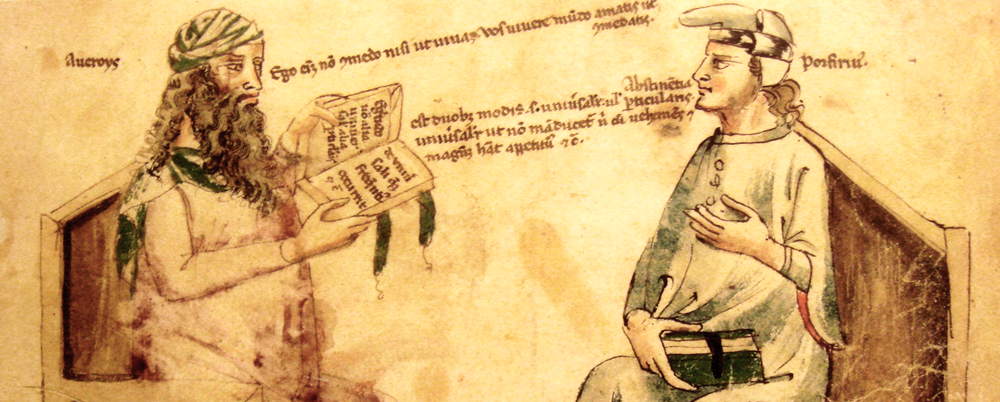SUBJECT MATTER
In Topoi, knowledge transfer was often addressed as a spatial process in which available knowledge is transferred from one region to another. However, apart from inter-regional there is a temporal form of knowledge transfer consisting in the transfer of knowledge from earlier to later generations. Besides oral traditions a crucial medium of intergenerational knowledge transfer are texts. Texts store available knowledge and make it accessible to future generations. Later receptions of earlier texts can require translation, i.e., reception can be intra- or interlingual.
It would be wrong to think that texts function like containers in that they “contain” knowledge that later generations gain access to by “opening” them. Neither are texts neutral “containers” of knowledge nor is understanding texts a passive “reception” of the knowledge they contain. Instead, texts are variously ambiguous and allow for different reasonable interpretations; and interpreting is an activity in which interpreters attempt to determine the most reasonable interpretations among the alternatives at hand. At the very least, interpreting incorporates the determination of possible readings and choosing the most reasonable of them. This activity, in turn, is constrained by conceptual and epistemic conditions pertaining to the interpreter as well as the aims of the interpreter. Thus, in interpreting an ambiguous text meets an active interpreter whose activity is constrained by her aims, conceptual resources, and epistemic condition.
Choosing a preferred interpretation goes along with a decision about the knowledge the interpreter considers the text to express. Of course, it would be wrong to restrict the content of texts to propositions; texts also make concepts accessible by the application of which propositional knowledge is articulated. In particular, interpretation often requires the identification of technical terms and their conceptual meaning. Often enough, new interpretations identify technical meanings that were not taken into consideration or were not at the interpreter’s disposal before. Due to this, interpretation comes along with changes in the conceptual repertoire of the interpreter. In the interlingual case, loan words and neologism are indicators for conceptual changes.
In a nutshell, the reception of texts is a source for conceptual and theoretical change.
PHASE 1 (2014/2015)
Against the backdrop of this hypothesis, in the Lab’s first phase we started discussing general views from philosophy and cognitive science of what concepts are and what conceptual change consists in. In further meetings, the participants presented examples of conceptual change from their research on ancient and medieval texts. In our group discussions, we applied general models of concepts and conceptual change to the presented cases, aiming at an improved understanding of the occurrences of central concepts in different texts from different periods.
Phase2 (2015-2017)
In our group discussions, we soon realised that the change of metaphors is central to the research of all the participants of Lab D. In order to make our topic of conceptual change more concrete and to tie it even closer to our individual research projects, we decided to focus our discussions on the particular case of change of metaphorical concepts. Early on we realised that metaphorical concepts do not merely play an aesthetic, but important cognitive roles in our texts. In order to provide us with required theoretical background knowledge about the cognitive role of metaphors we discussed:
- Metaphors we live by, by Lakoff & Johnson (1980)
- Metaphor. A Practical Introduction, by Kövecses (2010, 2nd ed.)
- „Conceptual Projection and Middle Spaces“, by Fauconnier & Turner (1994).
In addition, we took part in a workshop on metaphors and metonomies held by Daniel Werning (Lab C). The participants then presented in our meetings the use and change of metaphors in ancient and medieval texts. In our group discussions we attempted to clarify the meaning of the metaphorical terms, their cognitive role, and their change. In addition, we took a look at ancient and medieval accounts of metaphors. In particular, we discussed the following topics:
- Ideas as images in the writings of René Descartes und John Locke (Christian Barth, Lab D)
- Medieval accounts of metaphors and the idea of a mental language (Magali Roques, D-4)
- The soul as a pilot in neoplatonic psychology (Bettina Bohle, D-4)
- Medieval semantics of metaphors (Martin Klein, D-2)
- Being as a living being in neoplatonic philosophy (Antonio Vargas, BerGSAS)
- Art as imitating nature in ancient philosophy (Sean Coughlin, D-2)
Memory as wax/storehouse in ancient philosophy and medicine (Ricardo Juliao, D-2).
In order to join forces, in 2016 we started meeting together with Chiara Ferella and further members of the research group (C-2) Space and Metaphor who are also working on metaphors in ancient and medieval texts. This cooperation has turned out to be a very lively and fruitful. It resulted in the project of a joined volume on Metaphors in Ancient Cultures, edited by Chiara Ferella (C-2), Daniel Werning (Lab C), and Christian Barth (Lab D).
FURTHER INFORMATION
During the winter semester 2016/17, Christian Barth was on a replacement position at Konstanz University. No Lab D meetings took place in this period.
IMPLEMENTATION
In monthly meetings, the working group of Lab D provided space for a discussion of conceptual and theoretical change through reception and translation.
CREDITS
Image above: Imaginary debate between Averroes And Porphyry | Author: Manfredus de Monte Imperiali, Liber de herbis et plantis | Source: Bibliothèque nationale de France, Département des manuscrits, Latin 6823 | Public Domain

